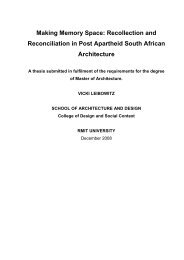Objects in Flux - RMIT Research Repository - RMIT University
Objects in Flux - RMIT Research Repository - RMIT University
Objects in Flux - RMIT Research Repository - RMIT University
Create successful ePaper yourself
Turn your PDF publications into a flip-book with our unique Google optimized e-Paper software.
<strong>Objects</strong> <strong>in</strong> <strong>Flux</strong><br />
24<br />
3. Remak<strong>in</strong>g Th<strong>in</strong>gs<br />
Chapter 3 documents my <strong>in</strong>itial <strong>in</strong>vestigations <strong>in</strong>to object modification<br />
and discusses the nature of the modification process. Through the<br />
construction of a public art event called FIX the research collected a<br />
number of faulty objects from members of the general public and attempted<br />
to fix these objects <strong>in</strong> <strong>in</strong>novative and unexpected ways. These<br />
material explorations present the act of modification as a complex<br />
negotiation between various cultural values, personal histories, functional<br />
language, and material constra<strong>in</strong>ts. Object modification is found<br />
to be a process of reth<strong>in</strong>k<strong>in</strong>g the object from with<strong>in</strong>, of f<strong>in</strong>d<strong>in</strong>g a path<br />
with<strong>in</strong> the object by which it may become someth<strong>in</strong>g other.<br />
4. Hack<strong>in</strong>g, Modd<strong>in</strong>g and DIY<br />
This chapter turns its attention to everyday acts of object modification.<br />
Tak<strong>in</strong>g a broad approach, the text exam<strong>in</strong>es practices of hack<strong>in</strong>g,<br />
modd<strong>in</strong>g and DIY and their representation with<strong>in</strong> society. From this<br />
diverse array of productive activity a general overview of these practices<br />
is developed and a number of common themes emerge. Practices<br />
are seen to privilege <strong>in</strong>dividual agency and creative play. While they<br />
are often anti-authoritarian <strong>in</strong> nature they are also highly social with<br />
practitioners actively seek<strong>in</strong>g out parallel projects and like-m<strong>in</strong>ded<br />
<strong>in</strong>dividuals. The public dialogue that emerges through these connections<br />
is highly self-reflexive and privileges the free and open exchange<br />
of <strong>in</strong>formation.<br />
5. Tell<strong>in</strong>g Stories<br />
Chapter 5 exam<strong>in</strong>es the discursive space generated by practices of<br />
object modification. The chapter is presented through two parallel<br />
streams; the ma<strong>in</strong> body of the text is taken up by stories from the field<br />
of object modification while the theoretical reflection on these stories<br />
is pushed to the marg<strong>in</strong>. The <strong>in</strong>tent here is to acknowledge that practices<br />
of object modification are sites of diverse production. This production<br />
is not simply materially based but also textual and social. The<br />
stories presented here mirror established forms of representation and<br />
engage a diverse community of practitioners. Taken together, these<br />
parallel texts describe a field of activity where participants actively<br />
construct their environment to match their beliefs and desires.
















